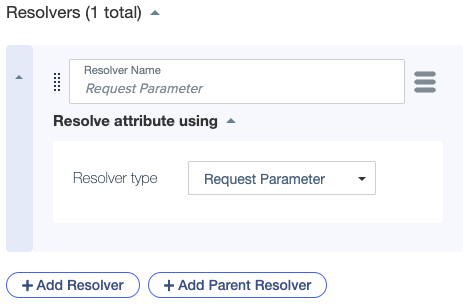Adding resolvers to an attribute
Optionally, add resolvers to define where an attribute pulls information from.
Before you begin
Add an attribute and configure the attribute’s general settings.
Steps
-
Add a resolver to the attribute:
-
In the Resolvers section, do one of the following:
-
Click Add Resolver.
-
Click Add Parent Resolver.
This is an optional shortcut that resolves the attribute against its parent. You can add a parent resolver if the attribute has a parent and doesn’t already have a parent resolver. If you add a parent resolver, skip step 1c.

-
-
Optional: Update the Resolver Name.
By default, the name is a combination of the resolver type and associated information, such as the attribute name for an Attribute resolver.
-
Select a Resolver type.
For more information about resolver types, see Resolvers.
-
-
Optional: To invoke a resolver only under certain conditions, add conditions to the resolver:
-
Click the hamburger menu next to the Resolver Name and select Add Condition.
You can remove a condition the same way.
-
To add a comparison to the condition, click Comparison.

-
Select an attribute to use in the comparison, select a comparator, and then enter a constant or click the Switch to Attribute (
 ) icon to select an attribute.
) icon to select an attribute.When you select an attribute, you can select a property that’s grayed out to generate an attribute that resolves against the parent attribute’s JSON schema. If the property is nested, generate an attribute for the property above first, and then generate an attribute for the child property.
-
To nest a comparison under another comparison, click Group.
Subgroups allow more permutations in comparisons. To remove nesting while keeping the comparison, click Ungroup.
-
To select a named condition, click Named Condition, select a condition, and then select is True or is False.
-
To combine multiple conditions, named conditions, or groups, select one of the following options:
-
All: Invokes the resolver when all of the conditions are true. If one condition evaluates to false, evaluation stops and the remaining conditions are not executed. This is like adding an
ANDBoolean operator between conditions. -
Any: Invokes the resolver when at least one of the conditions is true. If one condition evaluates to true, evaluation stops and the remaining conditions are not executed. This is like adding an
ORBoolean operator between conditions. -
None: Invokes the resolver when none of the conditions are true. This is like adding a
NOTBoolean operator.
-
-
-
Add processors to transform the value returned by the resolver.
For details, see Adding processors to an attribute.
Icons next to the Resolver Name field indicate at a glance whether a resolver has conditions, processors, or both.

You can copy resolvers defined in an attribute by selecting Make Copy from the hamburger menu of that resolver. Copying a resolver also copies any processors or conditions defined in that resolver.